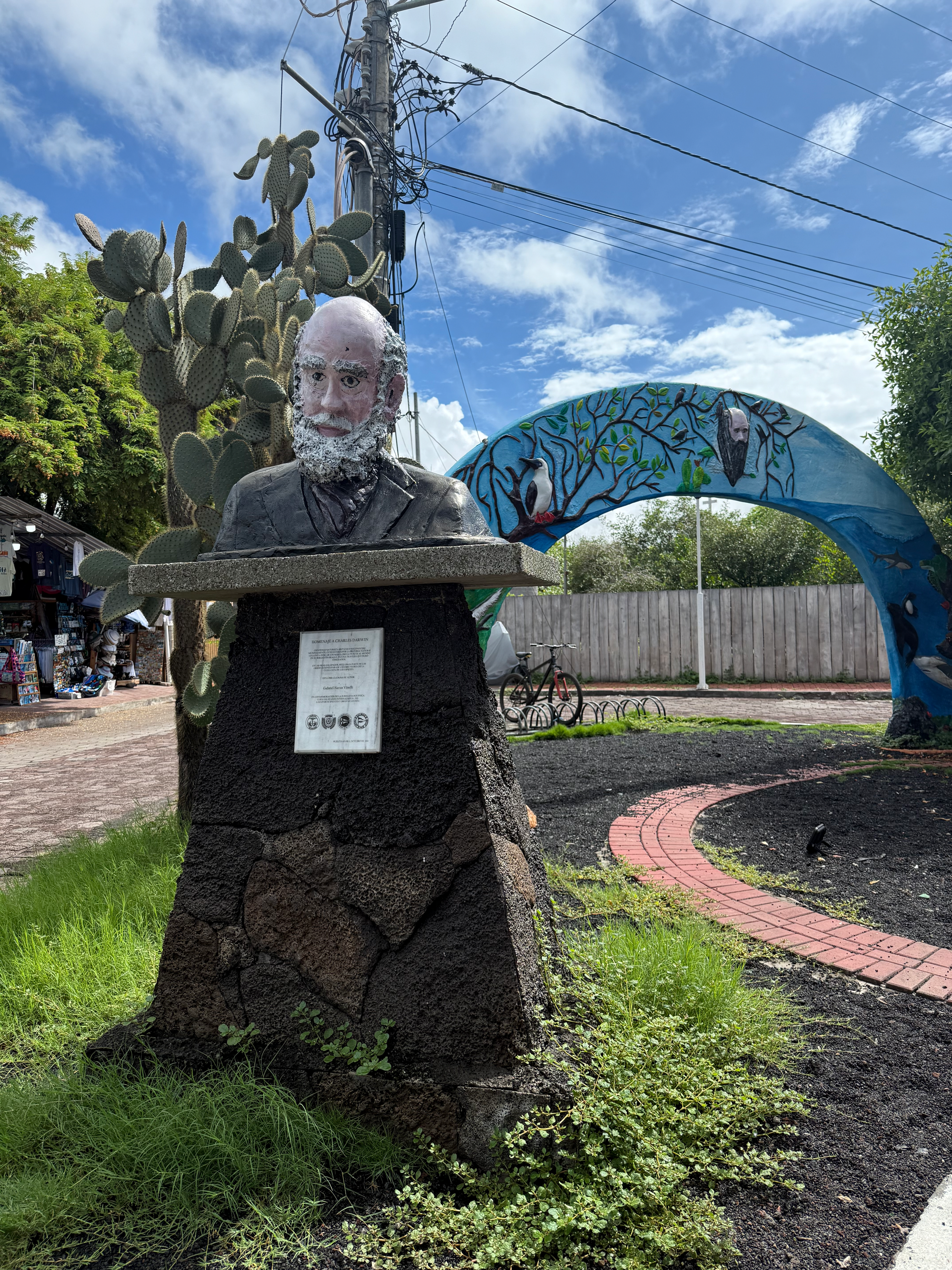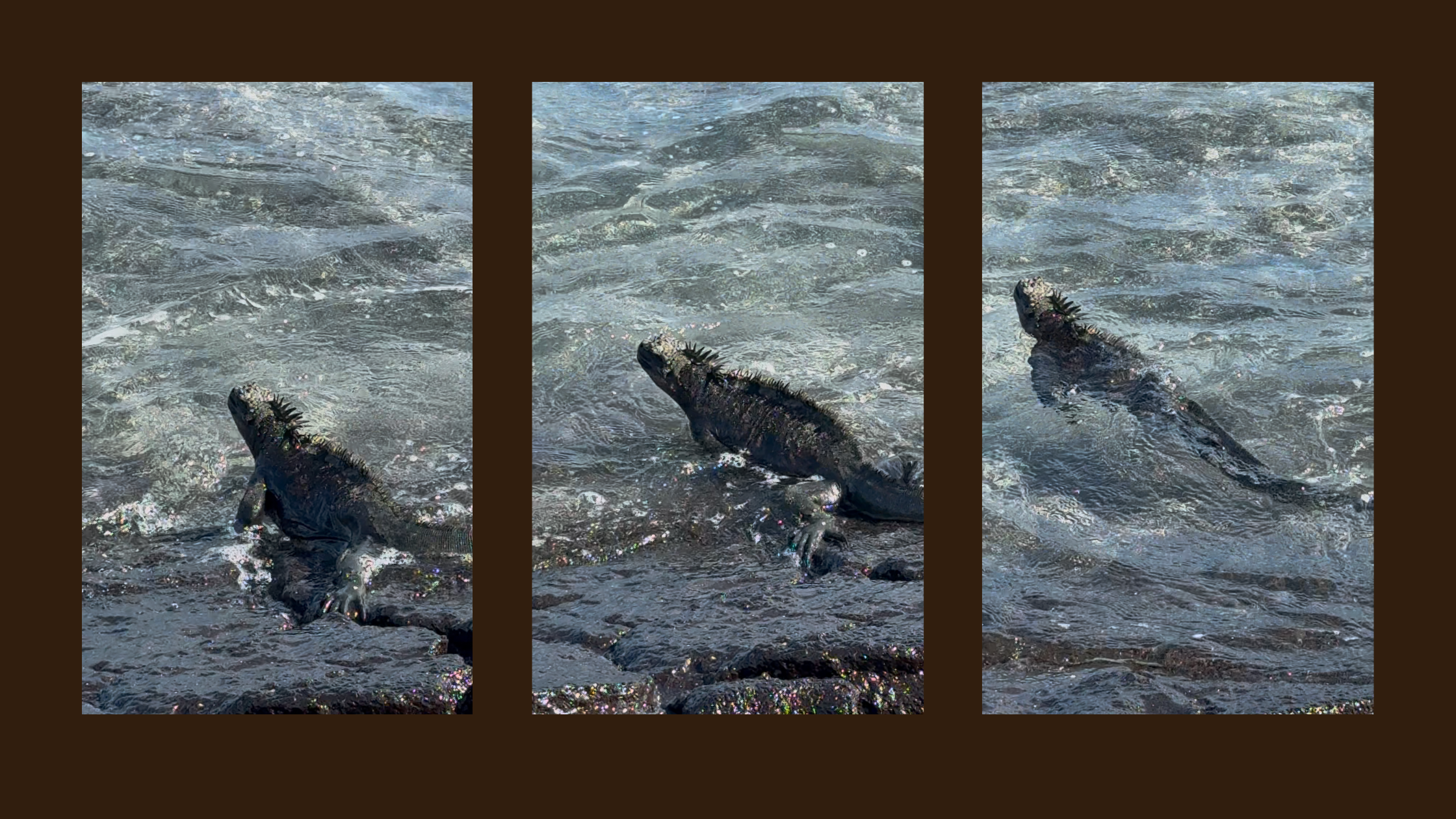Origins
Some family members gave us the tremendous gift of a family cruise to the Galápagos islands earlier this year. They had traveled there before, and they wanted the rest of the family to experience it, too.

Some family members gave us the tremendous gift of a family cruise to the Galápagos islands earlier this year. They had traveled there before, and they wanted the rest of the family to experience it, too. For any of you who–like me–don’t know much about the Galápagos besides a vague association with turtles, the Galápagos are a small, volcanic island chain on the equator off the coast of South America. When I mention the islands to people, I usually get two responses: 1. That place will change your life! 2. Oh, that’s where Charles Darwin recognized evolution! People are pretty nebulous in describing what kind of life change to expect. Usually something vague about nature being transformative. The islands themselves have an air of mystery about them. Pirates and adventurers who found their misty shores and unpredictable currents difficult to navigate called them the "enchanted aisles."
The Darwin connection is a little less mysterious. Charles Darwin traveled to the Galápagos in his early twenties as part of his famous voyage around the world in the HMS Beagle. In the Galápagos, he found several species that were like one another but distinct even between the islands. He also found many species unique to the islands. This prompts questions: What's the origin of these island species? How do these animals differ from their mainland counterparts? And why are they different from one another in the microcosmic Galápagos islands? Darwin would pursue those questions for the rest of his life, developing his theory of the origin of species beginning with his observations of the Galápagos animals.
As our cruise explored the islands, the Galápagos' impact on evolutionary theory seemed inescapable. It is a land that forces the questions “How?” and “Why?” over and over. You can SEE that the islands are geographically young. The eruptions of molten earth and rock from the ocean floor left evidence that is not subtle. Areas of new land, black and devoid of plant life, are evident even without active volcanic eruptions. Volcanic craters and cones remain visible, even in the islands' older areas.

You can’t help but wonder how animals arrived at this young land, a question that almost never occurs to me in other places. At home in Alaska, moose and magpies are just part of the place. Origin isn’t a question. But in Galápagos, you can hardly help picturing animals arriving on the nearly barren landscape… but how? Distance from other land keeps most land animals from reaching these islands. They’re even too remote for many bird species to fly there. The prevailing theory goes that the animals arrived by freak accidents. A strong windstorm that gusted birds to the aisles, with seeds in their gullets and beaks. A raft of dirt and plants that carried reptiles hundreds of miles over the open ocean. Those that could survive weeks without fresh water made it to the islands alive.
They arrived, but making a home there was its own challenge. The problem reminds me of human science fiction—you land somewhere with none of the food you can eat. How do you survive? The truth of adaptation of life is as obvious and in-your-face in the Galápagos as all the pesky questions that come to mind there. For Darwin, adaptation was most apparent in the 13 species of Galápagos finches that he collected on his voyage. Each was similar but for their size and subtle but significant differences in their beaks, enabling each species to eat different foods. Their bills are adapted to a wide range of eating methods: crushing food, probing (for insects in a tree or in the ground), grasping, and biting. Their diets range from entirely carnivorous to omnivorous to almost entirely herbivorous. All that variety in a group of birds that used to be a single species!
What is equally interesting to me is what did NOT happen. The finches that arrived and began populating the islands didn’t pick one way of eating and stick to it rigidly. They adapted into drastically different lifeways so that there would be diversity in their offspring. With so few species on such sparse islands, it is much easier to see how the eating habits of the different animals fit together snuggly like puzzle pieces. Everyone has their food supply and their place to breed. There is, of course, competition. However, successful survival hinges on finding a niche that minimizes conflict, not on dominating others. (Humans have a lot to learn here, don’t we?)
Darwin’s finches are far from the only species to adapt to the islands. The three species of boobies there also have drastically different and complementary eating and breeding habits. In the ultimate example of adaptation, an iguana learned to swim, accessing plentiful seaweed in shallow island waters. And not just swim, but dive and stay underwater for extended periods of time.
The complete story unfolds with closer examination. And of course, Darwin provided an explanation so powerful that his theory of evolution has become our scientific standard—species adapt or die. Of course, if an iguana survives by grabbing onto slippery ocean rocks with its forefeet, nature will favor iguanas with grippy toes, and, after many rounds of breeding, eventually the species will have longer toenails. But I still found myself with questions. A deeper “why” was still unanswered. Like, why did the iguana try the seaweed to begin with? Of course, millions of years witnessed trial and error. All the iguanas that landed on the islands tried many eating habits, from shellfish to cactii, but the one that was the most successful was the one that learned to swim to eat seaweed.
There is the knowledge you can learn and observe, but sometimes that is difference from the knowledge you gain by experience. The jackpot odds of an iguana eating seaweed makes sense until you see an iguana swim, until you look it in the eye and see a glimmer of knowing, until you sleep at night riding on the back of the same ocean that lifted the iguana onto the shores of the islands so many years ago, that made friends with it during its voyage on a raft of branches and leaves, then beckoned it to its waters for lunch. Perhaps there were one million years of trial-and-error decisions that led to millions of failed adaptations, like the sci-fi multiverse of possible decisions stretched out across these enchanted islands. But none of that satisfied. There was something about the iguana that my knowledge and experience struggled to understand. Something decisive in his leap into the ocean every time I saw it happen.

Darwin failed me there, as I read his book The Voyage of the Beagle about his trip around the world that included a stop in the Galápagos. He showed shocking disrespect for animal intelligence matched only by his willingness to end their lives. He began the voyage as a geologist. At first, he gathered specimens only as a happy byproduct of his passion for hunting. Almost every description of exotic animals in The Voyage of the Beagle is focused on the stupidity of the animal, how “pleasing” its appearance is or is not, and how easy or difficult it was or would be to kill or subdue. Of the boobies that have adapted their ways of eating, breeding, and raising their young alongside one another, not interfering with one another he wrote, “The birds are of a tame and stupid disposition, and are so unaccustomed to visitors that I could have killed any number of them with my geological hammer.” Of the marine iguana, “It is a hideous-looking creature, of a dirty black colour, stupid, and sluggish in its movements.” I read these and cannot help but wonder whether someone who has so little respect for the lives of other beings might be missing something when he tries to teach us about life itself.
I know some of my readers will pause here and think, Yes, where is the respect? And with it, the sense of awe and wonder? And point to God and his Great Design in the universe. We exceed random chance; a supernatural being directs us. While I appreciate the wonder that perspective brings to the experience of watching an iguana step into the water, I feel that awe sometimes glosses over important details. Perhaps there is a deity orchestrating it all, but that still doesn’t account for the spark of life in the iguana’s eye—dare I call it intelligence?
Like the animals that live there, I arrived on the islands by air and by water. There, the ocean became my friend. At the beginning of the trip, I was worried about my usual seasickness, but it didn't affect me this time. Whether on the cruise ship or the small inflatable tinders that transported us between the islands and the boat, in calm seas or large swells, I did not experience seasickness of any kind. As I grew confident that–at least on this trip–the sea was my friend, I spent most of the trip snorkeling. I moved with the ocean's rhythm, floating as effortlessly as the fish and sea turtles. I learned to tumble in the breakers near the shore. And, on the very last day, as I stepped out of a deeper pocket of water onto the beach, I felt the ocean lift me onto shore. It surprised me, this feeling of just enough pressure under my feet to tip me over a lip of sand and set me upright on two feet before the wave subsided.
There's the knowing you can get from a book, and then there’s an experiential sort of knowing, the kind you get when something that didn’t make sense falls into place. When that wave lifted me onto land, I suddenly experienced the secret knowing in the eye of the iguana as he pushes off into the water. It is knowing the ocean, knowing its supportive abundance keeping you afloat even while you’re sleeping. Knowing the mists it raises to confuse pirates and keep them away. Knowing the life-giving food just below its surface that it gives to the ones who need it, the ones who are willing to let it hold them up.
I was so shocked by the feeling of the ocean lifting me onto shore that I went back into the deeper water to try again. The ocean lifted me gently onto shore just as it had before. It taught me the one thing Darwin could not, perhaps that Darwin himself failed to learn: That all life is intelligent. Maybe not an intelligence of observation and analysis, but an intelligence of experience and survival. An intelligence of befriending the environment and living alongside others in the abundance one can find anywhere, even on a desert island.
Are you enjoying what you're reading? This is a reader supported publication. All content is free, but a paid subscription helps keep the lights on.
(Please note that I am not a non-profit organization. These gifts are not tax-deductible.)
Resources for this essay:
